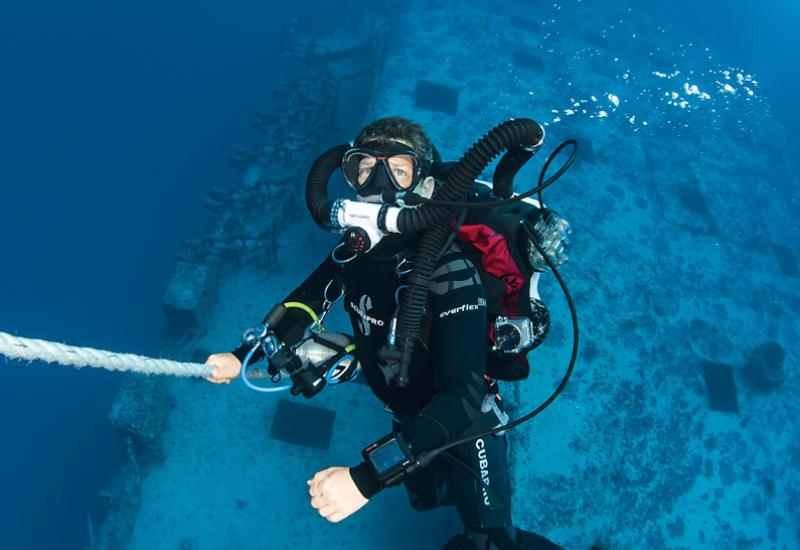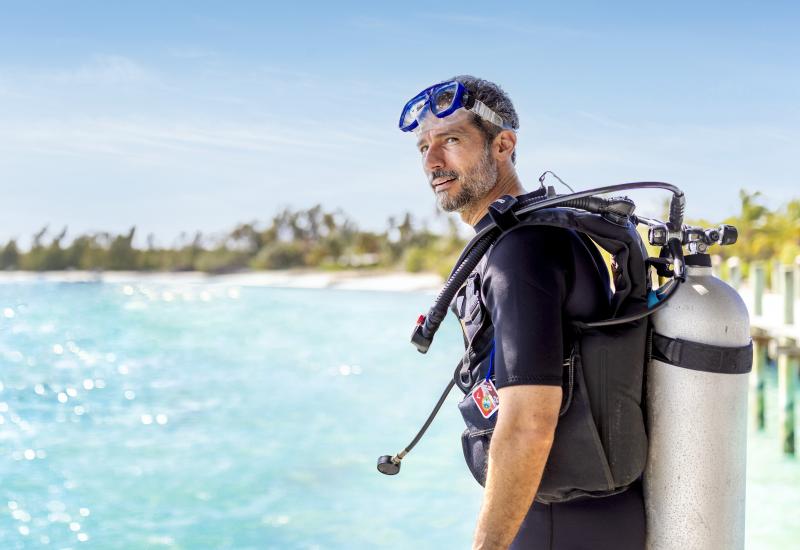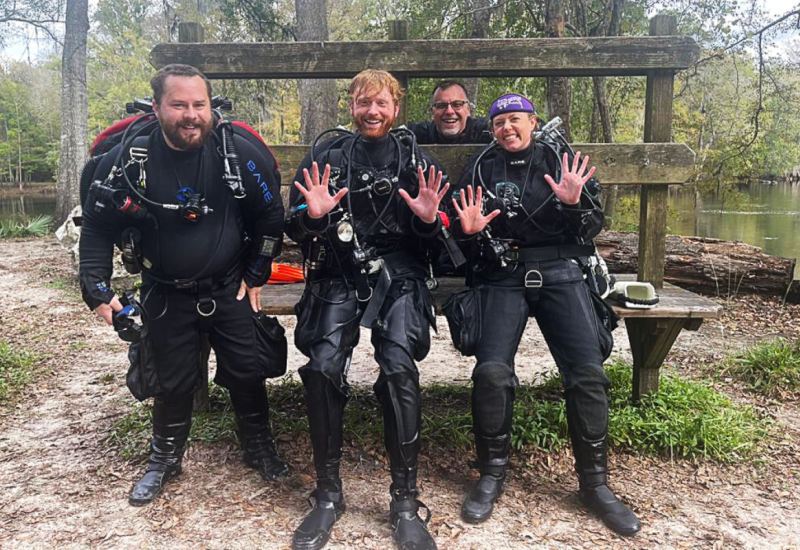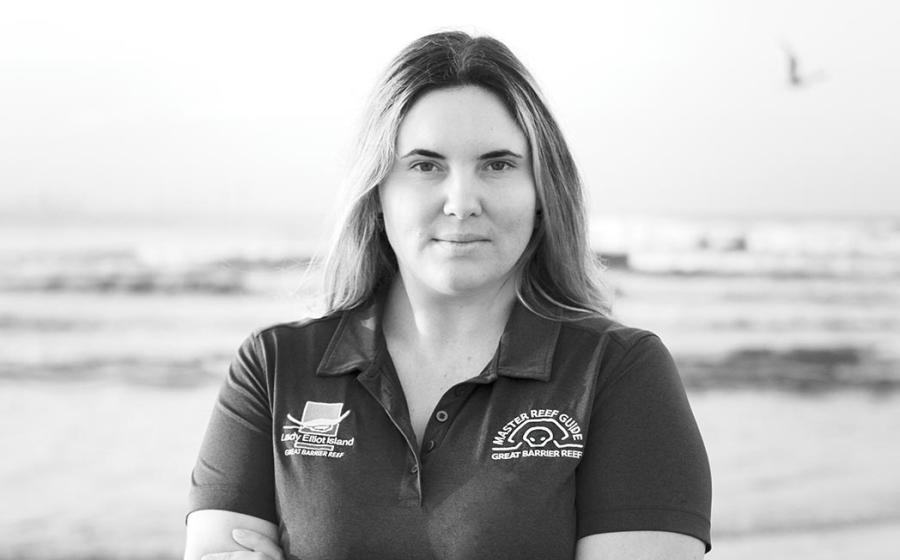How To Become a Scuba Diving Pro

Every diver has thought about it, whether standing on the deck of a dive boat after a beautiful day of tropical diving or flipping through the travel section of a dive magazine on a freezing winter night: Tossing off the shackles of everyday life, and becoming a dive professional. After all, what could be better than a life of warm tropical seas, cool ocean breezes and sharing your love for the sport of diving? The motivations of instructors and divemasters vary a great deal. Some hope to earn enough to pay for their hobby; some just want to dive as much as possible; and some turn it into a full-time career. And not all of them want to move to the tropics. As a diving professional, you can find work almost anywhere, from your local dive shop or university diving program to exotic live-aboards or island resorts. The benefits are undeniable. Of course, like everything in life, working in the dive industry isn't always a bed of roses. You take on a lot of responsibility for the safety and well-being of the students or divers in your charge, and for that reason, the industry will verify your skills and knowledge before turning you loose as a divemaster or instructor. You also need quite a bit of experience before you can start the process. A lot of questions come up among divers seriously considering professional training. So, if you're thinking about taking the plunge, here are the answers to help you get started.
What's the first step for turning pro?
There's a common misconception in the diving world that instructor classes are where divers learn the bulk of their professional-level underwater skills. Not true. The divemaster class, sometimes called "dive control specialist" training, is the real divers' boot camp. It's the first professional-level certification and the place where you learn dive management skills like how to lead and navigate dives, assist students above and below the water and manage diving emergencies. You'll also get in-depth academic education about the physics and physiology of diving, and you'll perfect your personal diving skills like buoyancy control, mask clearing and out-of-air procedures until you can effectively demonstrate them to students in a training environment. Part of your training is in the classroom, but a lot of it is in the water. And, of course, you are tested. At the end of your divemaster training, you are expected to have instructor-level knowledge in all of the academic subjects listed above and to demonstrate safe supervision and control of divers in real-world environments. You'll also be tested physically to ensure you have appropriate swimming skills and the endurance to safely rescue distressed divers in emergency situations. The tests vary among agencies, but generally you can expect an 800-meter swim with mask, fins and snorkel; a 400-meter free swim; an extended water tread; and a 100-meter rescue tow with both you and the victim in full scuba gear--all timed according to the limits specified by the training agency. Before successfully completing the program, divemaster candidates must also have current CPR, first aid and oxygen provider certifications issued by an internationally recognized organization such as DAN or the American Red Cross.
What are the prerequisites for the divemaster class?
Open Water, Advanced Open Water and stress-and-rescue/rescue-diving certifications are the only training prerequisites for enrolling in a divemaster program. You must be at least 18 years old and show a logbook with at least 60 dives, preferably in a variety of environmental conditions. Specialty certifications like night diving, deep diving and underwater navigation are not required, though added experience in these areas can be a big help during your training.
Which training agency should I use?
There are a handful of training organizations that offer professional-level dive training. PADI is the largest, but you shouldn't get too hung up trying to decide which one to train with — the programs are all fairly similar (NAUI and SSI are two other training agencies). If you plan to work for your local dive shop, then by all means, go with their primary training agency. On the other hand, if you're hoping to work in the tropics or bounce around a variety of resort or charter operations, it's best to go with one of the bigger agencies because, by virtue of their size and worldwide distribution, you'll have more job opportunities. But don't worry too much about it — once you get a divemaster or instructor certification with one agency, it's easy to cross over to another without going through the whole program again. Also, you have no obligation to do your divemaster or instructor training with the agency that issued your recreational certifications. For example, SSI's recreational certifications are perfectly acceptable as prerequisites for PADI's divemaster program, and vice versa.
What's the next step after divemaster?
Once you've completed your divemaster training, the next step on the scuba-learning ladder is becoming an instructor. Some agencies, like PADI for example, also offer an intermediate assistant instructor certification, which gives divemasters an opportunity to get added experience teaching students in a limited number of specialty areas, but an assistant instructor certification is not a prerequisite for instructor training.
What can I expect in the instructor class?
As explained earlier, instructor classes do not teach you how to dive. You should already have excellent water skills and diving knowledge from your divemaster training. An instructor class, typically called an Instructor Development Course (IDC) or Instructor Training Course (ITC), is all about learning how to teach those skills and academics to new divers. It will consist of mock training scenarios in a classroom, pool and in open water where you'll practice formatted teaching techniques, and learn about the business of diving and instructional methodology.
The instructor training process usually has two phases — training and evaluation — depending upon the agency. PADI's program, for example, starts with an eight-day IDC, followed by an intense, two-day evaluation process called the Instructor Examination (IE). During the IE, instructor candidates are evaluated on their ability to prepare and deliver in-water teaching presentations, demonstrate and effectively evaluate the skills of other divers, teach and perform rescue skills, and most important, maintain the safety of the students in their charge. Then they each have to organize a lesson plan randomly selected from the general diving curriculum and present the material clearly and concisely in a mock academic lecture that covers all of the content required in the topic area. Finally, all instructor candidates have to pass an academic exam on training standards and the business of diving, as well as the physics and physiology of diving learned in the divemaster program.
Where should I do my training?
Like your Open Water certification, there are plenty of options when deciding where to do your divemaster and instructor training, depending on the time and money you have available and your post-training employment goals:
The Local Dive Shop Almost all local dive shops offer divemaster classes/internship programs year-round because any Open Water instructor can teach those classes. IDCs/ITCs require a little more planning because they must be taught by instructor trainers, who aren't always available at every dive shop, and the classes must be coordinated with a regional IE session held by the associated training agency. If you want to do your training locally, talk to staff in your local dive shop about your timing options.
Heading South If you'd rather do your training in an island environment, you need to find a way to live on-island and support yourself while you study. Many high-volume dive destinations have operators with in-house instructor trainers, and some of these places offer divemaster/instructor internship programs, sometimes complete with room and board, that allow trainees to get real-world experience living, guiding and teaching in a resort environment. Koh Tao, Thailand, and the Bay Islands, Honduras, are two popular and inexpensive destinations for these types of internships.
The Career Institute For divers seeking a full-time career in diving, career institutes, like Hall's Career Center in the Florida Keys, offer comprehensive training programs as an interesting alternative to the normal instructor course options. The typical curriculum includes technical training in regulator repair, retail facility operations, compressor maintenance, boat handling and boat maintenance, in addition to the standard instructor course. These programs also offer a "no-experience option" that allows students to go from Open Water through Instructor in preparation for a career in diving. But do not be misled by the lack of prerequisite experience--these facilities are generally licensed vocational schools sanctioned by the post-secondary educational agencies in the state where they operate, and they do not take shortcuts. Divers starting at the bottom get all the prerequisite experience as they go through the numerous courses required to get to the instructor level. Graduating from a career institute can take six months or more, and the cost for a full program is between $20,000 and $30,000. But these schools also provide a more complete curriculum, job placement and a number of other benefits not typically available from the local dive store.
How do I find the best instructor?
Another important decision for aspiring divemaster or instructor candidates is which instructor or instructor trainer to use. This selection can be very important to your future career in diving. Look for an instructor who will teach you and test your abilities, in addition to providing training in areas that will help you build a successful resume or business model if you plan to work as an independent instructor. Watson DeVore, training director at SSI, suggests finding the right trainer by asking the advice of other divers and dive instructors whom you know and trust. Finally, when you think you have made your choice, interview the instructor trainer, be clear about your goals and get clear answers about how he or she will help you achieve them.
How much does it all cost?
A typical divemaster program costs about $500 for the course alone. Expect to spend another $300 or so on books, and be sure to budget for any dive equipment needs you have. In the U.S., IDCs generally cost between $1,200 and $2,000. If the training agency you select requires a separate instructor exam, plan to spend an additional $400 to $600 per exam--failing any part of the IE means you fail the whole thing, and if that happens, you'll have to wait for another IE later in the year and shell out the full exam fee once again to retake it. Instructor manuals and other materials, like training slates, will cost about $400. Tack on any related travel and lodging expenses, and the total cost can easily run to $5,000 or more, but this is fairly low compared to the cost of vocational training in other fields. Bob Brayman, owner of Hall's, says new instructors can earn between $20,000 and $40,000 depending on the diversity and level of qualification they bring to their positions. Of course, to get to the upper end of the spectrum you will need a few extra skills, like retail training and experience and a captain's license, that make you more valuable to the dive center.

Rod KleinTeaching others how to dive can be very rewarding.
Every diver has thought about it, whether standing on the deck of a dive boat after a beautiful day of tropical diving or flipping through the travel section of a dive magazine on a freezing winter night: Tossing off the shackles of everyday life, and becoming a dive professional. After all, what could be better than a life of warm tropical seas, cool ocean breezes and sharing your love for the sport of diving? The motivations of instructors and divemasters vary a great deal. Some hope to earn enough to pay for their hobby, some just want to dive as much as possible, and some would love to turn it into a full-time career. And not all of them want to move to the tropics. As a diving professional, you can find work almost anywhere, from your local dive shop or university diving program to exotic liveaboards or island resorts. The benefits are undeniable.
Of course, like everything in life, working in the dive industry isn't always a bed of roses. You take on a lot of responsibility for the safety and well-being of the students or divers in your charge, and for that reason, the industry will verify your skills and knowledge before turning you loose as a divemaster or instructor. You also need quite a bit of experience before you can start the process. A lot of questions come up among divers seriously considering professional training. So, if you're thinking about taking the plunge, here are the answers to help you get started.
What's the first step for turning pro?
There's a common misconception in the diving world that instructor classes are where divers learn the bulk of their professional-level underwater skills. Not true. The divemaster class is the real divers' boot camp. It's the first professional-level certification and the place where you learn dive management skills like how to lead and navigate dives, assist students above and below the water, and manage diving emergencies. You'll also get in-depth academic education about the physics and physiology of diving, and you'll perfect your personal diving skills like buoyancy control, mask clearing and out-of-air procedures until you can effectively demonstrate them to students in a training environment. Part of your training is in the classroom, but a lot of it is in the water. And, of course, you are tested. At the end of your divemaster training, you are expected to have instructor-level knowledge in all of the academic subjects listed above and to demonstrate safe supervision and control of divers in real-world environments. You'll also be tested physically to ensure you have appropriate swimming skills and the endurance to safely rescue distressed divers in emergency situations. The tests vary among agencies, but generally you can expect an 800-meter swim with mask, fins and snorkel; a 400-meter free swim; an extended water tread; and a 100-meter rescue tow with both you and the victim in full scuba gear — all timed according to the limits specified by the training agency. Before successfully completing the program, divemaster candidates must also have current CPR, first aid and oxygen provider certifications issued by an internationally recognized organization such as DAN or the American Red Cross.
What are the prerequisites for the divemaster class?
Open Water, Advanced Open Water and stress-and-rescue/rescue-diving certifications, and Emergency First Response Primary and Secondary Care (CPR and First Aid) training within the past 24 months are the only training prerequisites for enrolling in a divemaster program. Many divemaster candidates take the CPR and first-aid training at the same time as the Divemaster course. You must be at least 18 years old and show a logbook with at least 40 dives (60 dives by the end of the course), preferably in a variety of environmental conditions. You must have experience in night diving, deep diving and underwater navigation.
READY TO GET STARTED? FIND OUT MORE ABOUT PADI'S ELEARNING DIVEMASTER COURSE TODAY!

Rod KleinIf you enjoy diving and love teaching, why not consider a career as a scuba diving instructor?
What's the next step after divemaster?
Once you've completed your divemaster training, the next step on the scuba-learning ladder is becoming an instructor.
What can I expect in the instructor class?
As explained earlier, instructor classes do not teach you how to dive. You should already have excellent water skills and diving knowledge from your divemaster training. An instructor class, typically called an Instructor Development Course (IDC) or Instructor Training Course (ITC), is all about learning how to teach those skills and academics to new divers. It will consist of mock training scenarios in a classroom, pool and in open water where you'll practice formatted teaching techniques, and learn about the business of diving and instructional methodology.
The instructor training process usually has two phases — training and evaluation — depending upon the agency. PADI's program, for example, starts with an eight-day IDC, followed by an intense, two-day evaluation process called the Instructor Examination (IE). During the IE, instructor candidates are evaluated on their ability to prepare and deliver in-water teaching presentations, demonstrate and effectively evaluate the skills of other divers, teach and perform rescue skills, and most important, maintain the safety of the students in their charge. Then they each have to organize a lesson plan randomly selected from the general diving curriculum and present the material clearly and concisely in a mock academic lecture that covers all of the content required in the topic area. Finally, all instructor candidates have to pass an academic exam on training standards and the business of diving, as well as the physics and physiology of diving learned in the divemaster program.
Where should I do my training?
Like your Open Water certification, there are plenty of options when deciding where to do your divemaster and instructor training, depending on the time and money you have available and your post-training employment goals:
The Local Dive Shop Almost all local dive shops offer divemaster classes/internship programs year-round because any Open Water instructor can teach those classes. IDCs/ITCs require a little more planning because they must be taught by instructor trainers, who aren't always available at every dive shop, and the classes must be coordinated with a regional IE session held by the associated training agency. If you want to do your training locally, talk to staff in your local dive shop about your timing options.
On Location If you'd rather do your training in an island environment, you need to find a way to live on-island and support yourself while you study. Many high-volume dive destinations have operators with in-house instructor trainers, and some of these places offer divemaster/instructor internship programs, sometimes complete with room and board, which allow trainees to get real-world experience living, guiding and teaching in a resort environment. Koh Tao, Thailand, and the Bay Islands, Honduras, are two popular and inexpensive destinations for these types of internships.
How do I find the best instructor?
Another important decision for aspiring divemaster or instructor candidates is which instructor or instructor trainer to use. This selection can be very important to your future career in diving. Look for an instructor who will teach you and test your abilities, in addition to providing training in areas that will help you build a successful resume or business model if you plan to work as an independent instructor. Find the right trainer for you by asking the advice of other divers and dive instructors whom you know and trust. Finally, when you think you have made your choice, interview the instructor trainer, be clear about your goals and get clear answers about how he or she will help you achieve them.










